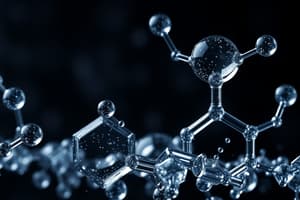Podcast
Questions and Answers
What defines a functional group in organic chemistry?
What defines a functional group in organic chemistry?
- It is a class of hydrocarbons characterized by their solubility.
- It is a separate molecule that interacts with hydrocarbons.
- It is a group of atoms responsible for the molecule's specific properties. (correct)
- It is a group of atoms that determines the molecule's size.
Which functional group is represented by the structure -COOH?
Which functional group is represented by the structure -COOH?
- Carboxyl group (correct)
- Hydroxyl group
- Amino group
- Carbonyl group
What is the primary characteristic of a hydroxyl group?
What is the primary characteristic of a hydroxyl group?
- It contains an -OH configuration. (correct)
- It consists of a sulfur atom and a hydrogen atom.
- It is involved in double bonding with oxygen.
- It is found only in carbohydrates.
Which statement about the methyl group is accurate?
Which statement about the methyl group is accurate?
What role does 'R' play in the representation of organic compounds?
What role does 'R' play in the representation of organic compounds?
Which of the following groups is not a major functional group found in biological molecules?
Which of the following groups is not a major functional group found in biological molecules?
Which functional group is described as containing a nitrogen atom attached to two hydrogen atoms?
Which functional group is described as containing a nitrogen atom attached to two hydrogen atoms?
Which functional group can be identified by the structure C=O?
Which functional group can be identified by the structure C=O?
What are polysaccharides primarily composed of?
What are polysaccharides primarily composed of?
Which polysaccharide serves as the main form of stored carbohydrate in the body?
Which polysaccharide serves as the main form of stored carbohydrate in the body?
Which of the following is true about cellulose?
Which of the following is true about cellulose?
Chitin is primarily found in which of the following?
Chitin is primarily found in which of the following?
What structural feature distinguishes chitin from cellulose?
What structural feature distinguishes chitin from cellulose?
Which polysaccharide is known for being an ideal storage molecule for energy?
Which polysaccharide is known for being an ideal storage molecule for energy?
What percentage of total organic carbon on Earth does cellulose comprise?
What percentage of total organic carbon on Earth does cellulose comprise?
What characteristic is true for polysaccharides in general?
What characteristic is true for polysaccharides in general?
What is another name for the sulfhydryl group?
What is another name for the sulfhydryl group?
Which class of organic molecules is characterized by the formula (CH2O)n?
Which class of organic molecules is characterized by the formula (CH2O)n?
What type of reaction is characterized by the loss of a water molecule when two substances are joined?
What type of reaction is characterized by the loss of a water molecule when two substances are joined?
What distinguishes aldoses from ketoses in monosaccharides?
What distinguishes aldoses from ketoses in monosaccharides?
Which of the following is a primary role of the phosphate group in nucleotides?
Which of the following is a primary role of the phosphate group in nucleotides?
Why can't humans digest cellulose?
Why can't humans digest cellulose?
What type of carbohydrate consists of two monosaccharides?
What type of carbohydrate consists of two monosaccharides?
What are the basic building blocks of nucleic acids?
What are the basic building blocks of nucleic acids?
Flashcards are hidden until you start studying
Study Notes
Overview of Organic Chemistry
- Organic chemistry studies carbon-containing compounds, focusing on their structures, synthesis, and reactions.
- Organic molecules, primarily hydrocarbons, feature carbon atoms bonded to hydrogen and other elements.
Functional Groups
- Functional groups are specific atom arrangements that grant molecules characteristic properties.
- Major functional groups in biological molecules include:
- Hydroxyl (-OH)
- Methyl (-CH3)
- Carboxyl (-COOH)
- Carbonyl (C=O)
- Amino (-NH2)
- Phosphate (-PO4)
Methyl Group
- The methyl group is the smallest hydrocarbon functional group (-CH3).
- Methylation plays a role in regulating gene expression, protein function, and RNA metabolism.
Hydroxyl Group
- The hydroxyl group (-OH) is present in alcohols, phenols, and carboxylic acids.
- Common in biological molecules, found in carbohydrates, amino acids, and nucleic acids.
- Ethanol (EtOH) is an example of a molecule containing a hydroxyl group.
Carbonyl Group
- The carbonyl group features a carbon atom double-bonded to an oxygen atom (C=O).
- Exists in two varieties: at the end (aldehyde) or in the middle (ketone) of a carbon chain.
Carboxyl Group
- The carboxyl group (-COOH) consists of a carbon atom double-bonded to an oxygen atom and bonded to a hydroxyl group.
- Present in carboxylic acids and amino acids.
Amino Group
- The amino group (-NH2) consists of nitrogen bonded to two hydrogen atoms.
- Found in all amines and amino acids, it provides bonding opportunities due to the presence of a lone electron.
Sulfhydryl Group
- Comprises a sulfur atom bonded to a hydrogen atom (-SH).
- Known as a thiol group, this functional group is important in biological systems.
Polysaccharides
- Complex carbohydrates made of monosaccharide chains linked by glycosidic bonds.
- Ideal for energy storage, large and insoluble, and fold into compact shapes.
Types of Polysaccharides
- Glycogen: A branched polysaccharide stored in animals’ liver and muscles; it serves as the main carbohydrate reservoir for glucose.
- Cellulose: The most abundant organic compound, crucial for plant structure; it is fully permeable to water and solutes.
- Chitin: An unbranched polysaccharide found in arthropod cuticles and fungal cell walls, similar to cellulose.
Phosphate Group
- Part of nucleotides (-PO4); critical for energy transfer in cells (ATP).
- Regulates protein function depending on its presence or absence.
Monomers and Polymers
- Oligomers consist of fewer than 50 monomers linked together.
- Condensation reactions join substances with the loss of a water molecule.
- Hydrolysis reactions involve water being added, resulting in decomposition.
Classes of Organic Molecules
- Four major classes include:
- Carbohydrates
- Proteins
- Lipids
- Nucleic Acids
Carbohydrates
- Composed of carbon and water in the ratio of one carbon to one water molecule (CH2O)n, often referred to as saccharides.
- Types include:
- Monosaccharides (e.g., glucose, fructose): Single sugar molecules.
- Disaccharides (e.g., lactose, sucrose): Formed from two monosaccharides.
- Polysaccharides: Composed of multiple sugars, which can be similar or diverse.
Families of Carbohydrates
- Aldoses: Have a carbonyl at the end of the carbon chain.
- Ketoses: Have a carbonyl within the chain, commonly as 2-ketoses.
Starch vs Cellulose
- Starch is digestible due to alpha glycosidic linkages.
- Cellulose has beta glycosidic linkages, making it indigestible for humans due to a lack of suitable enzymes.
Studying That Suits You
Use AI to generate personalized quizzes and flashcards to suit your learning preferences.




